Shree Melamchi-Ghyang Secondary School
Set high in the mountains Melamchi-Ghyang School is the most out of this world place we could ever have imagined working in. With roughly 250 pupils, 2/3 boys and 1/3 girls, it’s a community based government school offering ‘hostel’ boarding accommodation to all pupils from outside the village. This facility is necessary as the only access road (we would call it a rough dirt track) becomes impassable during the monsoon season making the only alternative route for pupils (aged between 4 and 16) a tough 3hr upwards trek. Despite it’s remoteness, the school’s success and growing popularity means that children from all over Nepal are sent to this hidden gem, miles from anywhere.
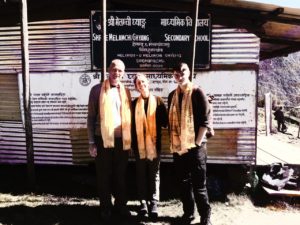
Steve, myself and Alex having been welcomed to the school

Steve and Purna, the headmaster outside the school office. Not a school day as Purna isn’t wearing his usual pin striped suit!
At the helm is the inspirational and charismatic headmaster, Purna. He’s the formidable driving force behind everything the school achieves. Leading by example he expects the highest standards and committment from staff and pupils alike and strives to give everyone the best tools and opportunities to excel. Impressive results are achieved here, a few years ago the son of a yak hearder and pupil at Melamchi-Ghyang school graduated from Manchester university with a medical degree.
The children are worked hard – it’s a 6 day school week for everyone. Saturday is a holy day and so the only day off.
Every other day is business as usual and goes like this –
Outdoor assembly at 8:30 gets the day started and is only ever cancelled if raining. All pupils stand in rows of boys and girls with the smallest at the front and the tallest at the back. The rows are then ordered by house colour, Blue, Red, Green and Yellow. Everyone has a small scrap of ribbon pinned to their jumpers to indicate their house and the girls, who all have long hair, tie appropriate coloured bows around their plaits and bunches – it’s very cute. Everyone follows exercises as instructed by a fellow pupil from the stage (a Nepali version of shake and wake), the school prayer is then sung followed by the Nepali national anthem. Recently voted the second best in the world, it’s a stirring tune, especially hearing it sung outside with the views of the himalaya all around. It gets me going nearly every morning!
Pupils, chosen either by house or by class then go onto the stage to recite a poem, ask a couple of questions, tell a joke, dance or sing. Their representative teacher is also expected to do something at the end and there’s no getting out of it – I know, I’ve tried!
Last week worming pills were handed out to everyone, with mouths checked that they’d been swallowed successfully. Apparently this happens 6 monthly.
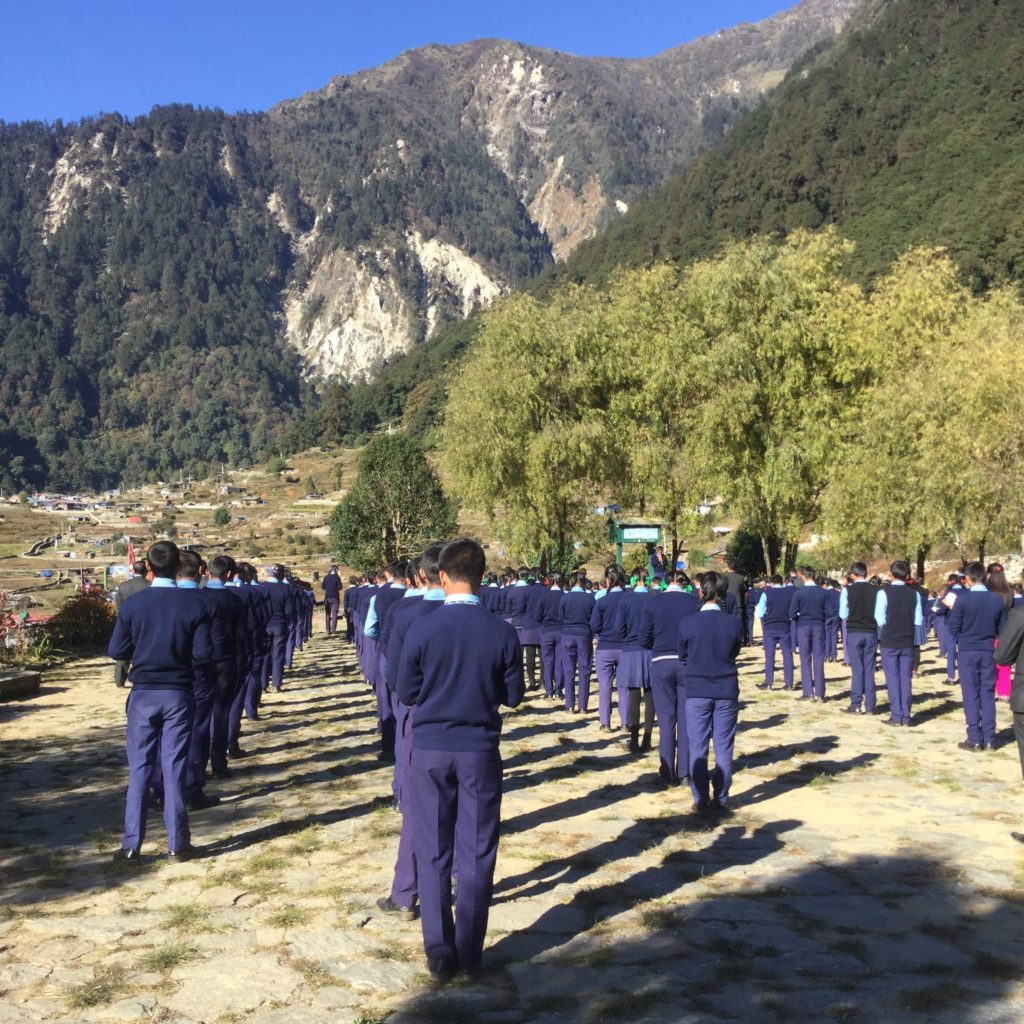
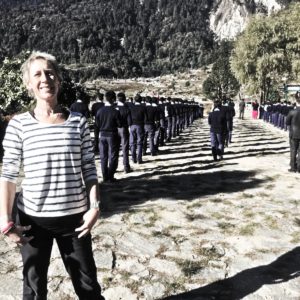

Just about ready to go on the assembly stage…
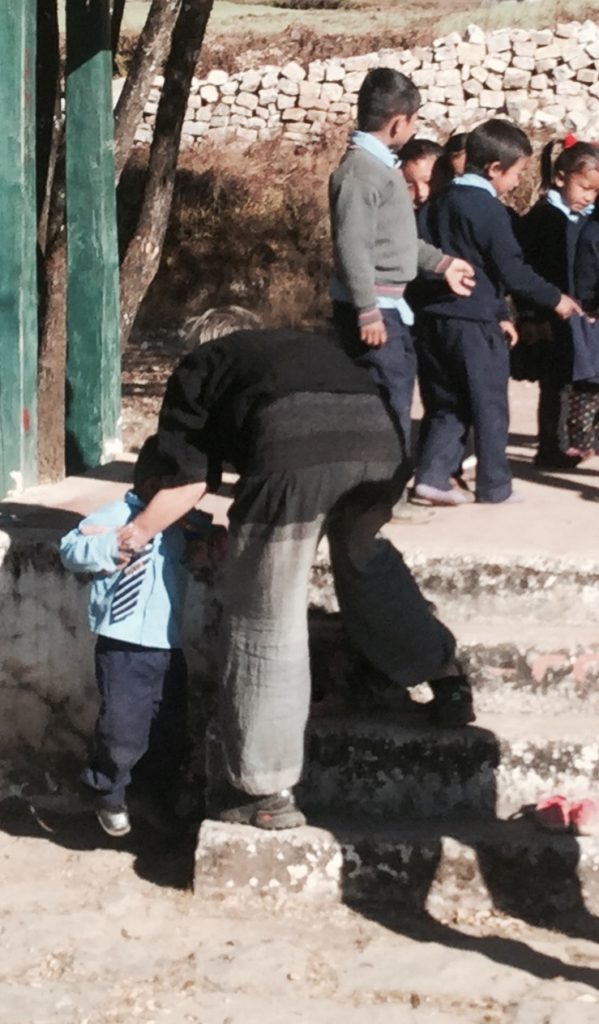
It’s big steps for a little person!
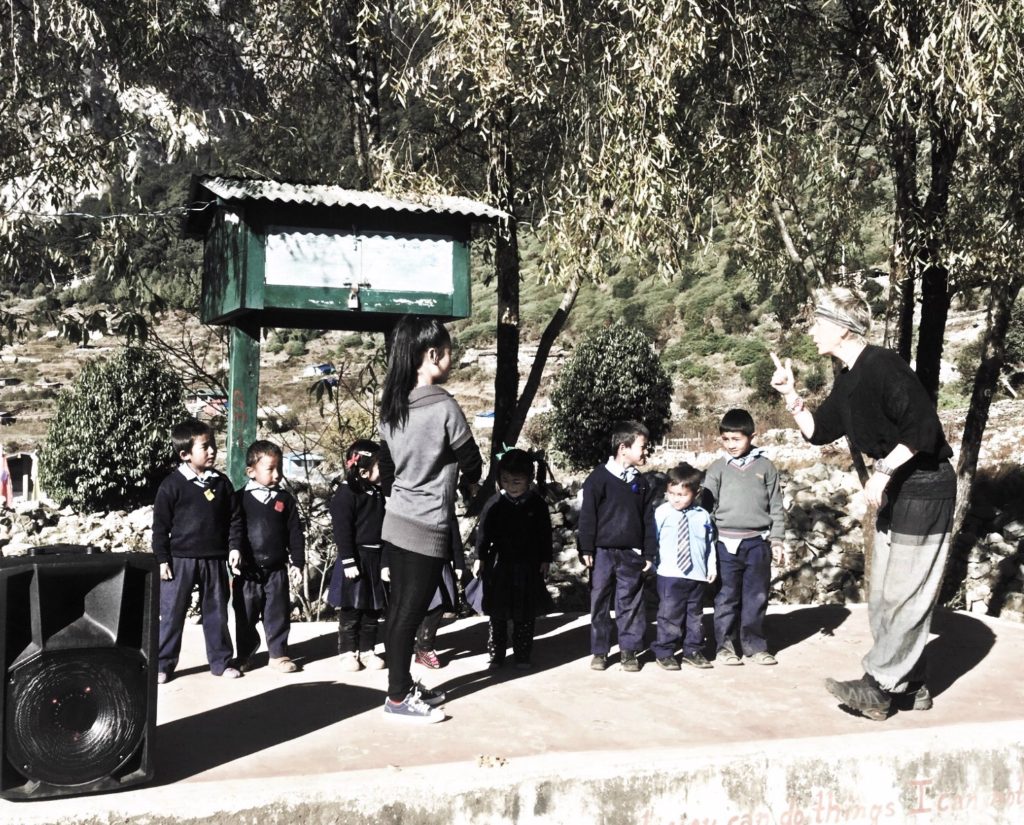
In complete control during my class’ heads, shoulder, knees and toes assembly rendition…
Lessons start at 9:00. The morning consists of 4 forty-minute lesson periods with a 10 minute break half way through. There is an hour for lunch which is followed by another 4 forty-minute lessons including another midway break. The second outdoor assembly of the day for everyone in the winter months is at 3:30 before hometime at around 4:00. During the summer the day is half an hour longer and was shortened only a couple of weeks ago for the winter months. It’s getting noticeably colder now and with no form of heating anywhere on the school campus it becomes too chilly for study to take place after this time.
Except…
Years 9 and 10 who are in exam mode and so expected to be at school to start lessons at 6:00 am. They don’t go home (apart from lunch) until 5:30pm and when they do finally get home, as with all the other pupils in the school (except for my kindergarten and nursery class) they will have homework in most subjects taught during the day. Any homework defaulters are hauled up on stage during one of the following day’s assemblies! This timetable lasts until March next year, so continues through the coldest, darkest months.
School uniform is navy with striped ties. Coats (non uniform) are allowed to be worn at all times of the day now, outside and inside the classroom. My little ones start the week, Sunday, looking very smart and tidy. By Friday many of them are filthy, mostly the boys. Twice yearly parents are asked to measure their children and any uniform needed is bought to them from Kathmandu.
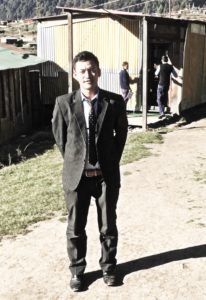
The male teachers all wear dark pin stripped suits and ties of their choice, the female staff wear bright pink local dress. They all look very smart.
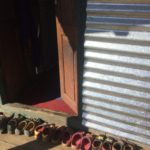 Traditionally shoes are not worn inside, so they are left outside the classroom during lesson time.
Traditionally shoes are not worn inside, so they are left outside the classroom during lesson time.

Children help keep the classrooms, headmasters office, hostels and canteen areas clean using little hand brushes/brooms which work an absolute treat. No such things as Hoovers or employed cleaners here!
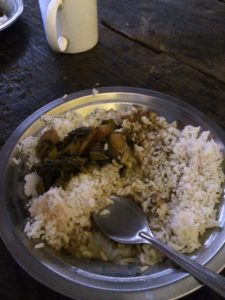 Lunch consists daily of the local dish Dahl Baht cooked over 3 large woodburning cooking stoves. It’s an impresive feat catering for so many children and teachers in this basic way. The food served is absolutely delicious and there’s plenty of it. Where possible all produce is bought from farmers in the village. By helping local people make a living from selling their goods it’s a win win situation for everyone involved.
Lunch consists daily of the local dish Dahl Baht cooked over 3 large woodburning cooking stoves. It’s an impresive feat catering for so many children and teachers in this basic way. The food served is absolutely delicious and there’s plenty of it. Where possible all produce is bought from farmers in the village. By helping local people make a living from selling their goods it’s a win win situation for everyone involved.
With lunch comes a mug of hot water.
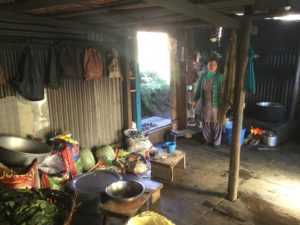
The school kitchen
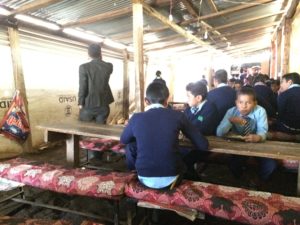
School canteen
When the days were warmer I thought it was tough job for the chef and kitchen staff working by the fires all day. Now that it’s colder I feel complete envy!
The school buildings are all still temporary structures following the devastation of last year. After the earthquake struck it took just 1 month for the school to be back up and running. Impressive in any situation, but especially so when all buildings were destroyed beyond use and had to be rebuilt from scratch using only the rubble around them. What was achieved is a testament to the tenacity of the staff and the community, particularly considering that everyone was living under canvas in miserable conditions at the time.
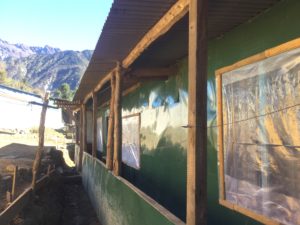
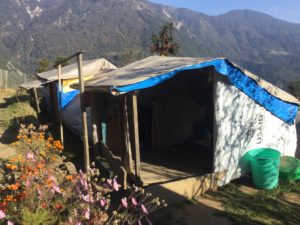
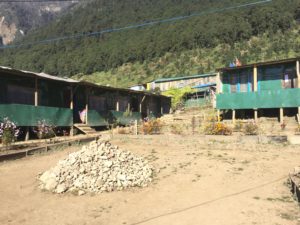
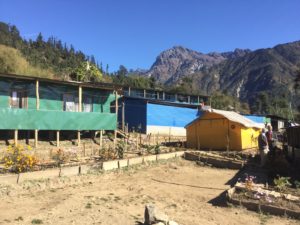

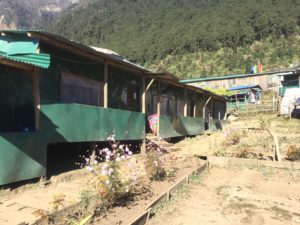
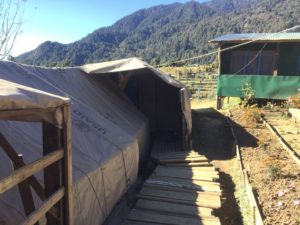

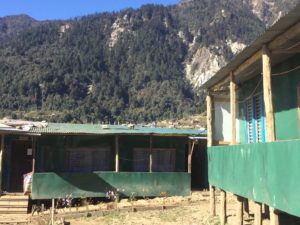
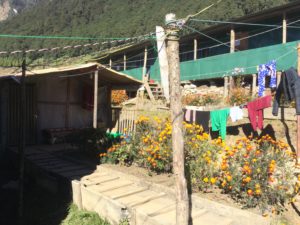
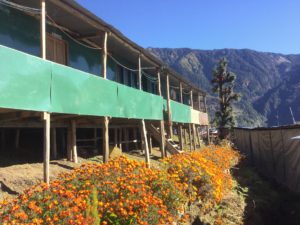


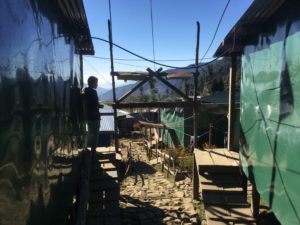

Girls dormitory room
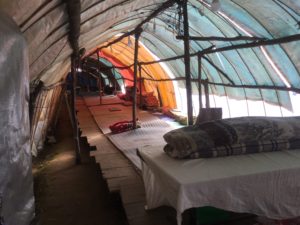
The only structure to remain unharmed after the earthquake was this poly tunnel. Used for vegetables at the time it was cleared and converted to an emergency shelter housing over 300 people in one go! The girls now use it as their study space.
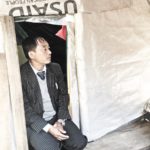
Housemaster and English teacher Tika Limbu in his tented accommodation. He actually has a tent inside a tent!
The temporary hostel accommodation has been made as comfortable as possible under the circumstances. There are separate girls and boys boarding houses. Some are raised tin structures, all are lined with ply for insulation. The teachers are still living under canvas!
The shower facilities are basic but there are taps and hot/warm water generated by solar power. Proper shower fittings are on Steve’s to do list.
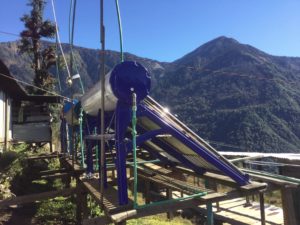
Solar system

Shower Block

Toilet Block
Fast forward 20 months and the situation at the school is this –
Engineers have visited during the last few weeks to give an idea on how now to proceed, costings etc. The boarding hostels, classrooms, wash facilities, canteen, kitchen and headmasters office all need to be rebuilt following new government earthquake resistant guidelines. Some funding is already in place, but more financial support will be needed to complete the project. Community Action Nepal have committed to help with a substantial portion of what’s needed, but as with many other charities here the disaster last year has pulled on their resources. It’s hoped that everything will be in place for work to start next year with a completion date in 2 to 3 years time.

Danny from Belgium with Purna the headmaster
Some teachers are funded by the government, many by outside sponsors and we’ve been lucky enough to meet some guys from Belgium who do just that. They arrived bearing gifts of clothes and shoes amongst other things which were greatly and eagerly received by the children at the school.
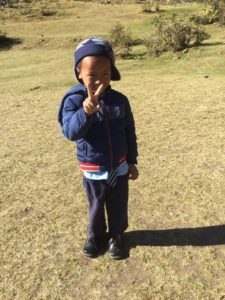
Many of them are still wearing the clothes and shoes they were given that day. We were also lucky enough to spend some time with Corin, a computer/IT whizz who was actually in the school at the time of the earthquake! He has experienced village and school life pre, during and post the disaster – he is a bit of a legend in the village!
Huish Primary in Yeovil, the school where our son teaches, is very kindly fund raising for Community Action Nepal throughout this school year. The pupils have already been busy raising  money with a copper coin collection and a bookmark sale. We’ve heard that they’ve been incredibly generous with their own time and money. Steve and I would like to take this opportunity to thank them for their hard work and generosity.We appreciate all that they are doing for the people of Nepal and are really looking forward to re-visiting the school to thank everyone in person and share our experiences with them later next year.
money with a copper coin collection and a bookmark sale. We’ve heard that they’ve been incredibly generous with their own time and money. Steve and I would like to take this opportunity to thank them for their hard work and generosity.We appreciate all that they are doing for the people of Nepal and are really looking forward to re-visiting the school to thank everyone in person and share our experiences with them later next year.
When the children here found out about what Huish School were doing for them they wanted to send letters to the pupils there. I was blown away with how much care they took and how enthusiastic they were about writing and decorating them – there were no homework defaulters on that day! They are so excited about sending the letters and are even more excited about hearing back. Two schools in different continents caring about the bigger picture – inspiring.
Here are just a few examples of year 5’s masterpieces.
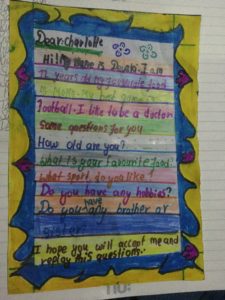

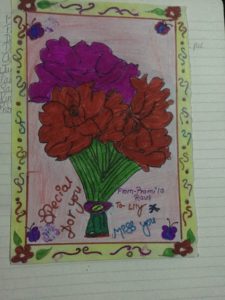

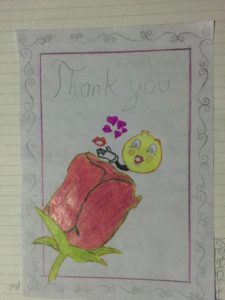
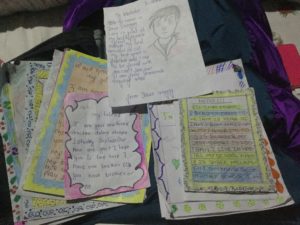
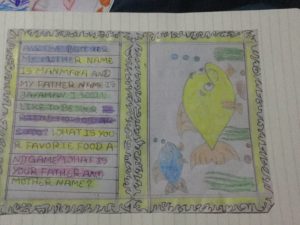
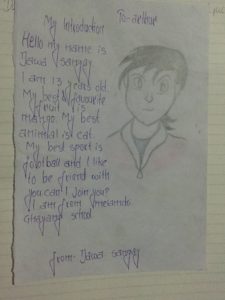

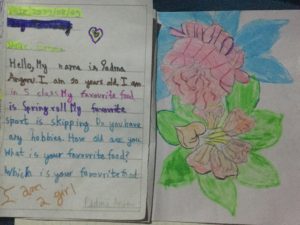

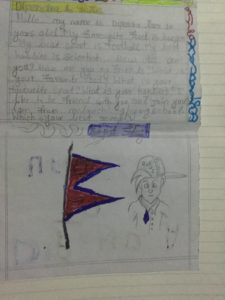
For myself, teaching the little ones continues and I’m loving it – all of them are completely adorable. They do the Nepali shaky head thing which is just so endearing on Sherpa children who are cuter than cute anyway! The day includes English, handwriting, maths, creative play, outdoor activities and Nepali (not my forte!). We’ve drawn round our hands and feet, counted fingers and toes, coloured in rainbows and drawn faces. I’ve also been spending time getting together some lesson plans for teachers to use when I leave – It’s been fun using my creativity and I’m hoping it will be of some benefit to the school going forward. I’m also looking forward to helping with some English lessons with the older children before I leave.
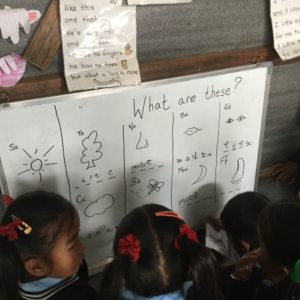
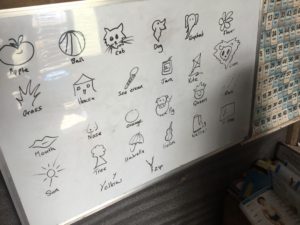

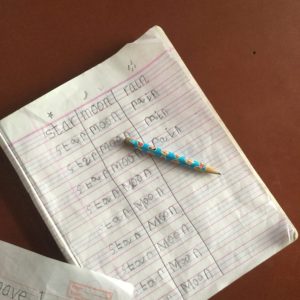
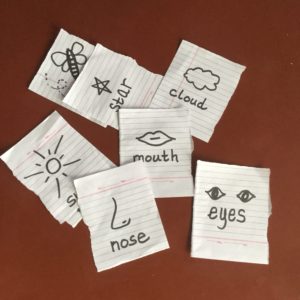
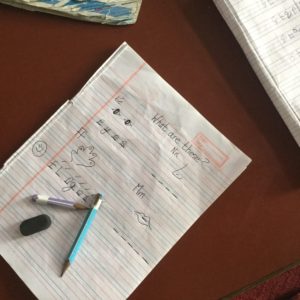
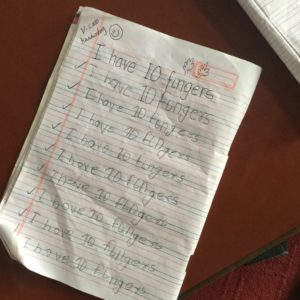


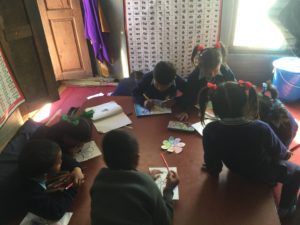
Steve’s here there and everywhere doing just about everything…
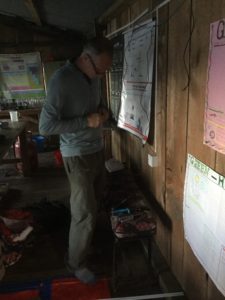
He’s mended the 5 school microscopes, he’s fitted light sockets, he’s insulated classrooms, he’s put up a shelf for me (his most important task yet), he’s taken science lessons and field trips, he’s fixed the failing water supply to the school, got the wifi back on track – the list goes on. At the moment he’s spending less time in school and more time in the forest with the local men folk assessing what’s needed to improve the village water supply over the coming weeks.
Accurate calculations are required for plumbing parts needed as it’s at least a 3 day trek to Kathmandu for anything forgotten or missed off the list!
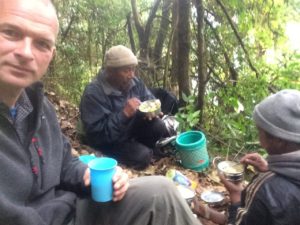
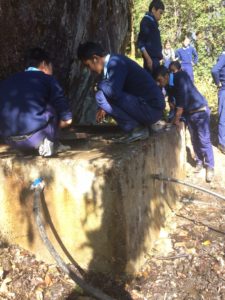
Year 8 pupils checking out the source of the school water supply
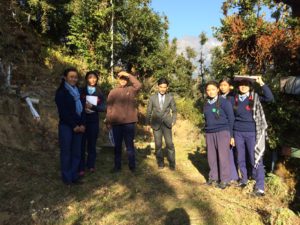
Steve’s science field trip to the wetlands
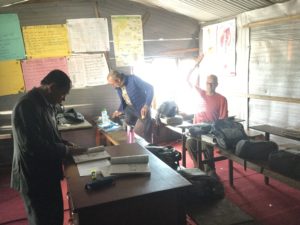
Corin and Steve misbehaving in class!
We’ve been asked to do some voice recordings for the English listening syllabus – hilarious, I’ve taken a school assembly – terrifying and Steve has been asked to sing in front of a class when they found out he was in a choir – awkward!
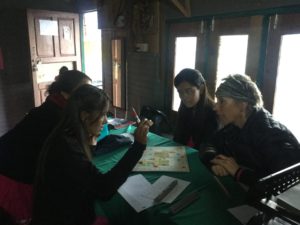
We’ve also taught the staff how to play scrabble so they can play (in English) with the students. You’d think we’d have an unfair advantage over the local guys but I came last!
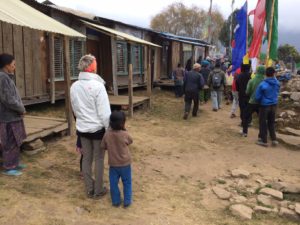
With little friends at the funeral…
The final school fact for now is that the school is at present the home of the sacred village funeral pyre. Originally set well away from the village it now, (since the earthquake) sits bang slap in the middle of the school grounds and temporary classrooms. Last week sadly the body of a local man was found after he slipped and fell whilst cutting tress in the forest that surrounds the village. The school was shut for the funeral ceremony and the cremation of his body. We were invited to attend and felt privileged to do so. It’s something few outsiders experience and a day we shall never forget – we’ll save the details for another post.
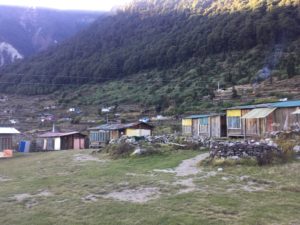
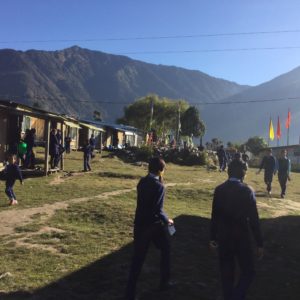
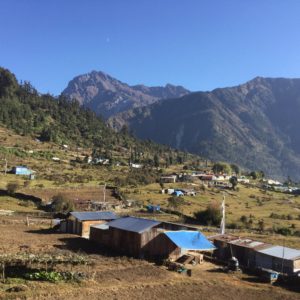

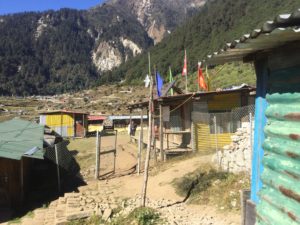


Boarding pupils’ cutlery


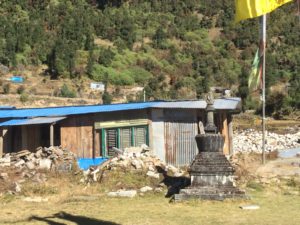
My classroom
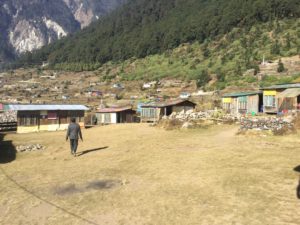
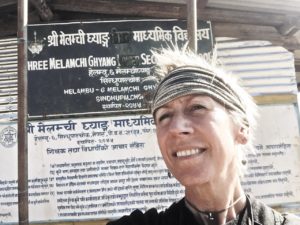
This school, it’s staff and it’s children will remain in our hearts long after we return home. It’s a special place that we shall never forget.
P.S did I mention I’m bringing at least 20 children home with me (don’t tell Steve!).
Here are a few of them…
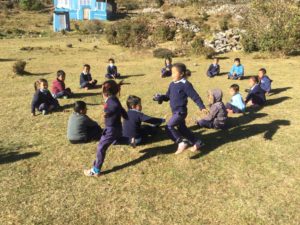
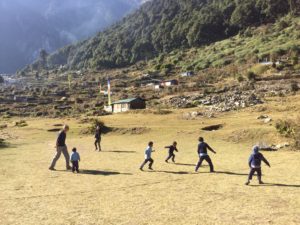
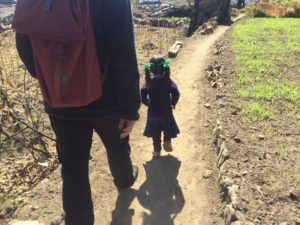
Home Time

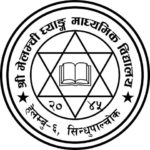
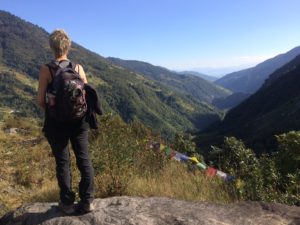
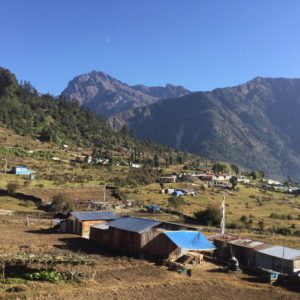
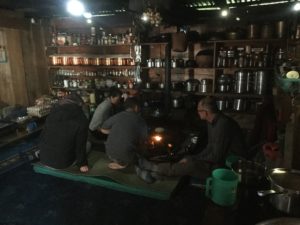
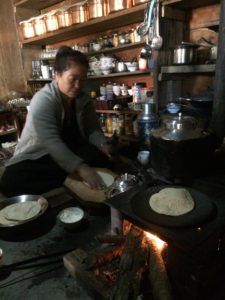

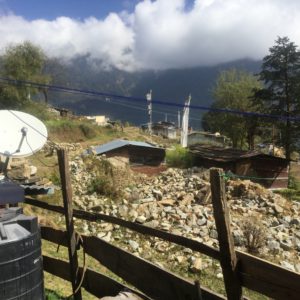
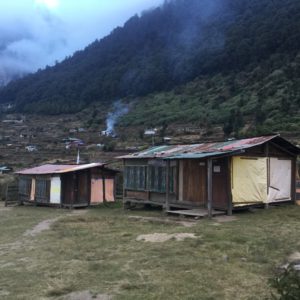
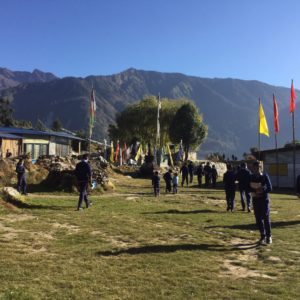

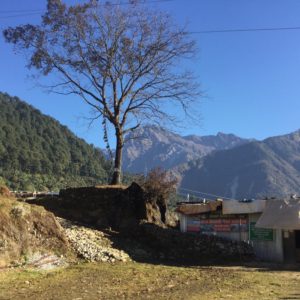


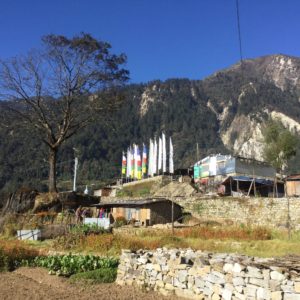




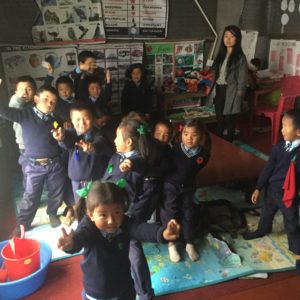
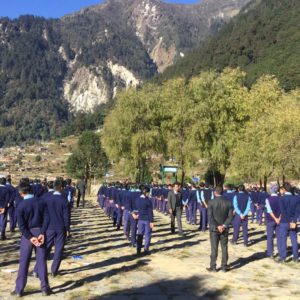

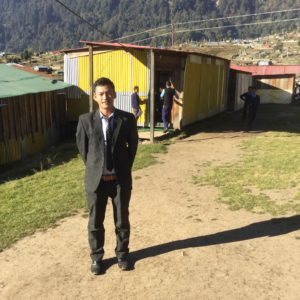
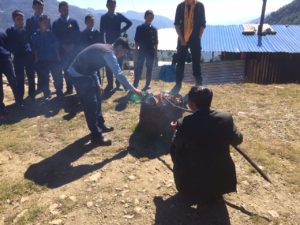
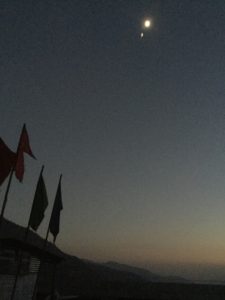
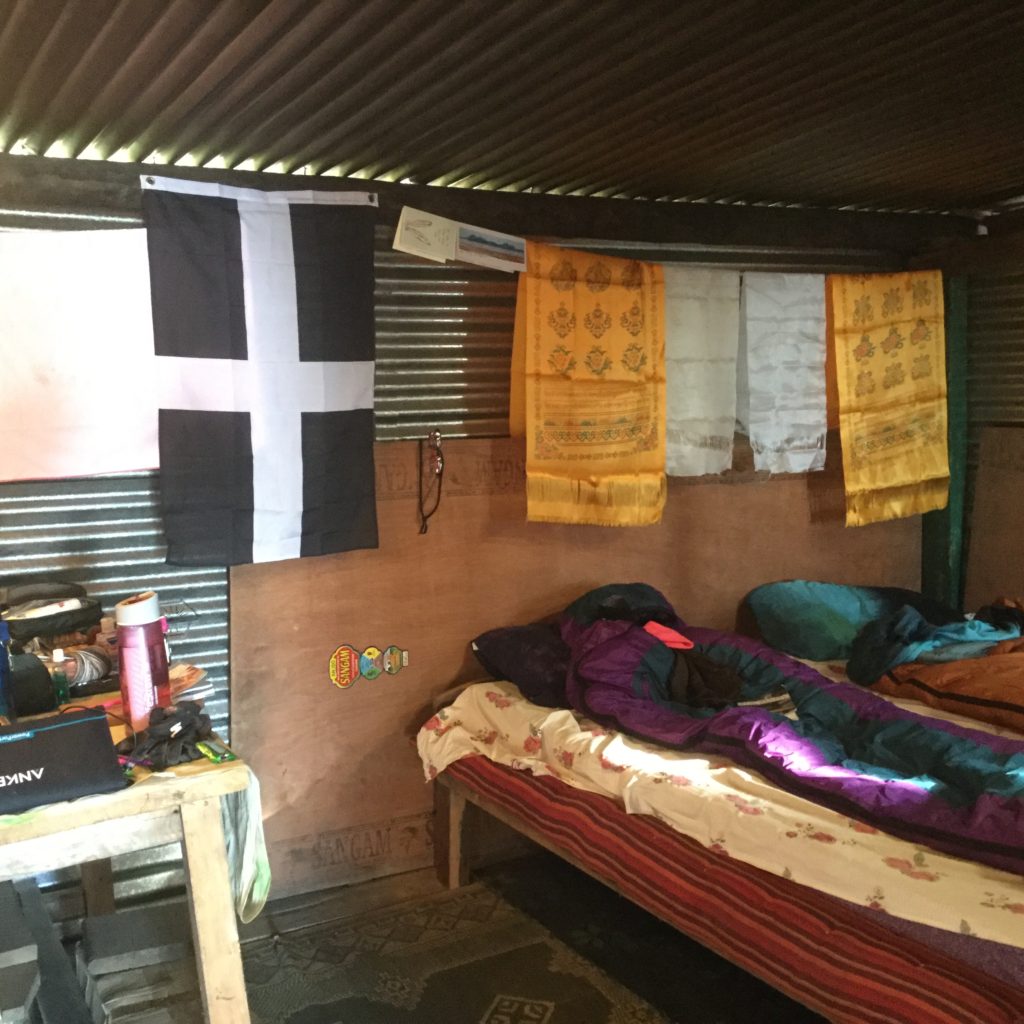
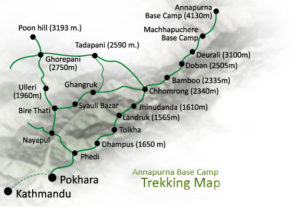



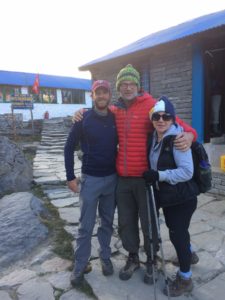

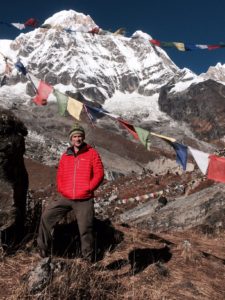

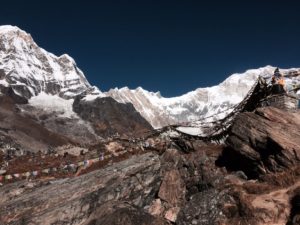
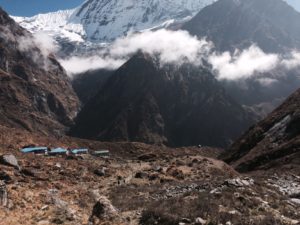
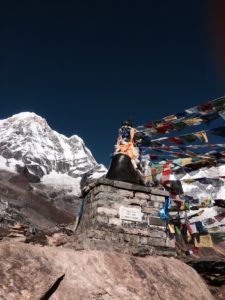

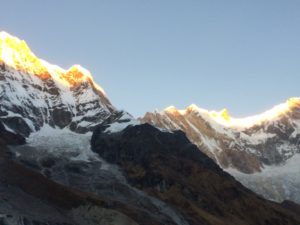
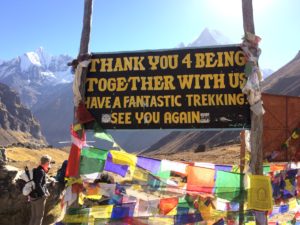

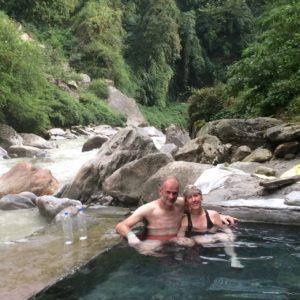

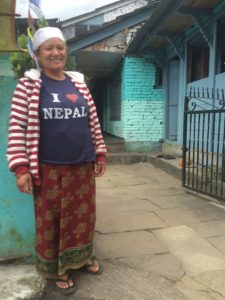
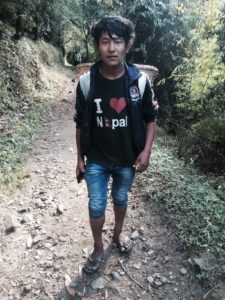
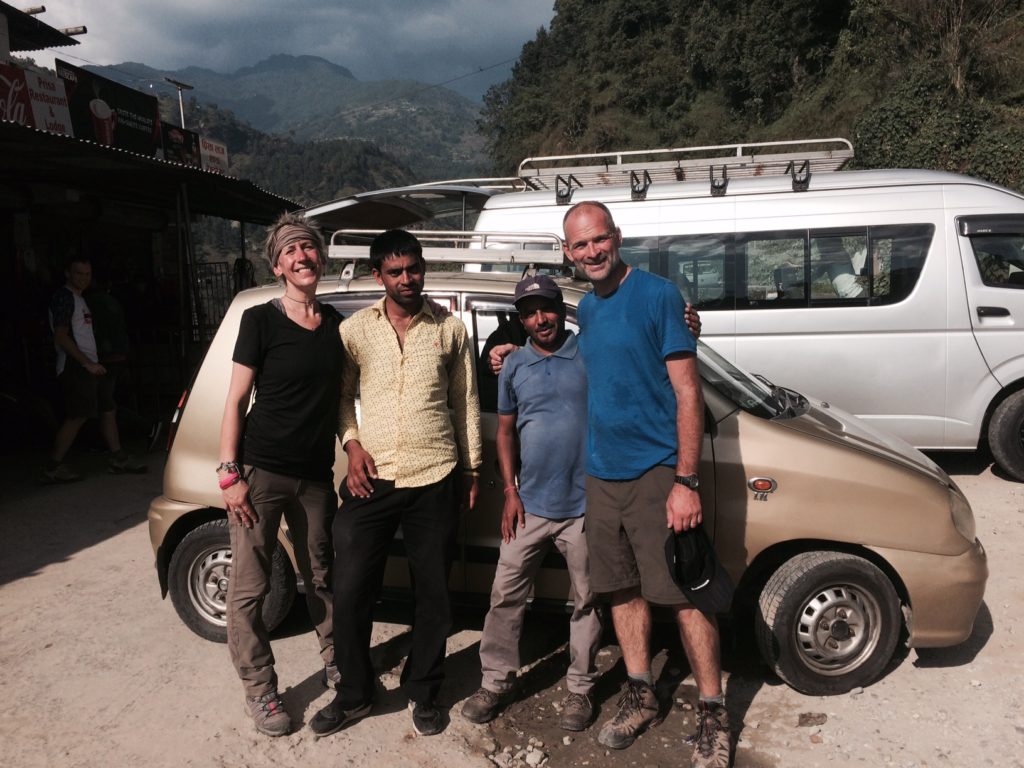


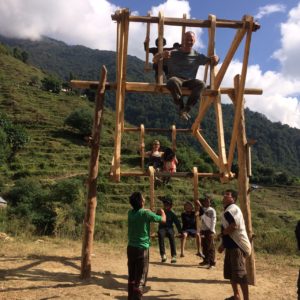
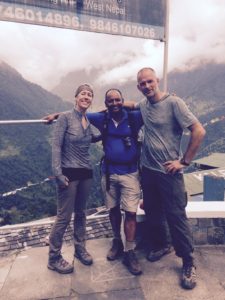
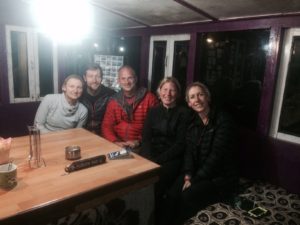

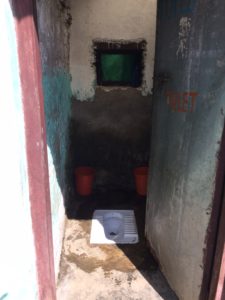


 This trek was very kindly arranged by Bicky (
This trek was very kindly arranged by Bicky (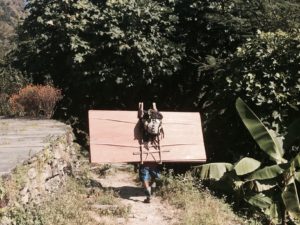
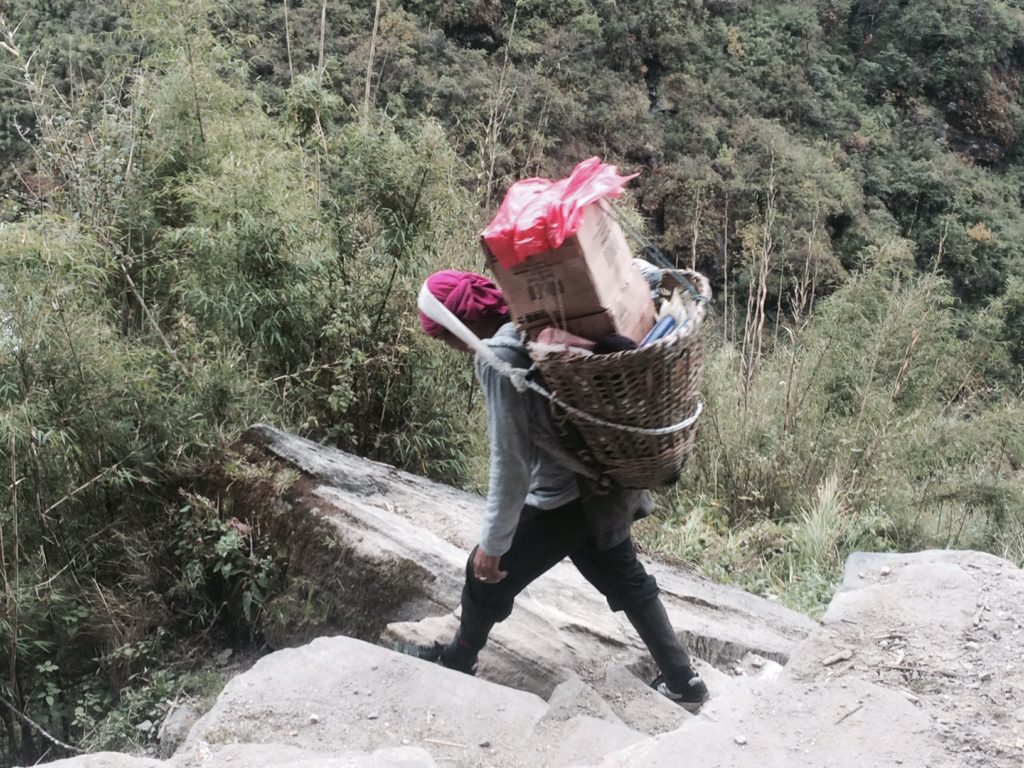
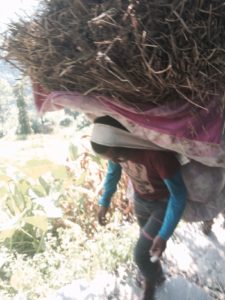

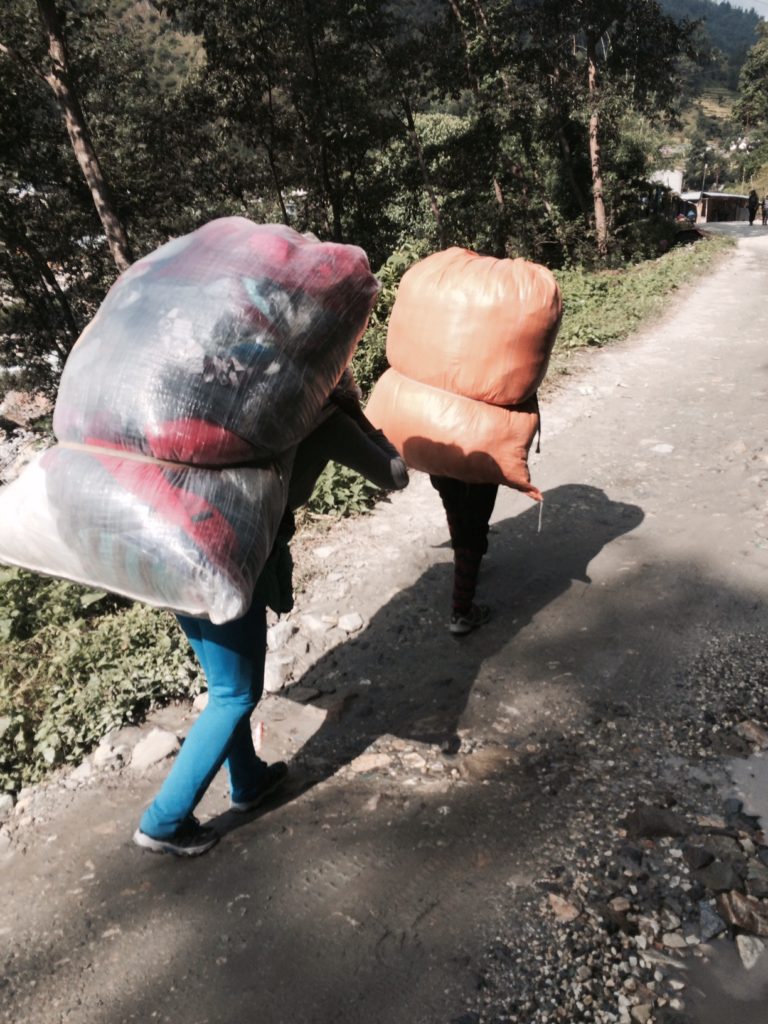
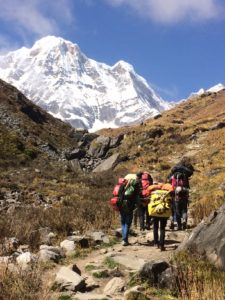


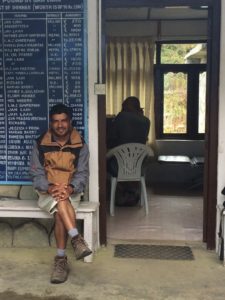
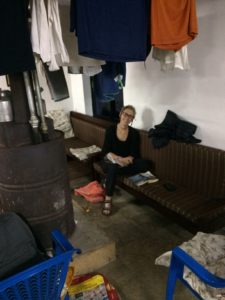
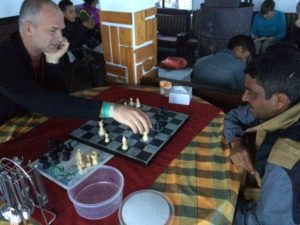

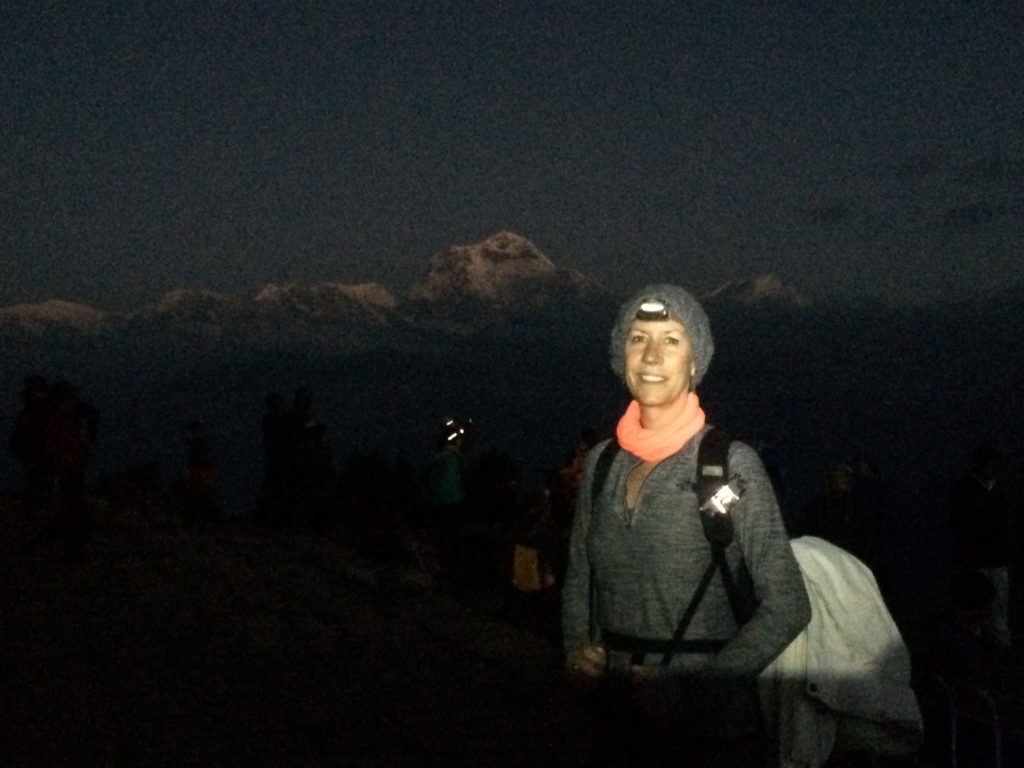
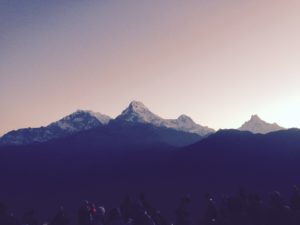
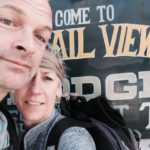

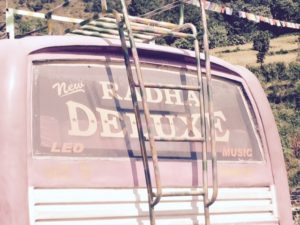

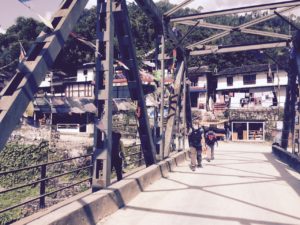 To walk to Annurpurna Base Camp, trekkers are required to buy permits and the first part of our trek was interrupted by having these checked at various checkpoints. Steve and I were fizzing with excitement, eager to get going and just so incredibly happy to be heading for the mountains – our adventure was about to become yet more exciting.
To walk to Annurpurna Base Camp, trekkers are required to buy permits and the first part of our trek was interrupted by having these checked at various checkpoints. Steve and I were fizzing with excitement, eager to get going and just so incredibly happy to be heading for the mountains – our adventure was about to become yet more exciting. Apart from camping, all accommodation on the trail is in the form of Tea Houses. With their distinctive blue paintwork, Tea Houses offer basic accommodation with not much more than beds in the rooms and mostly shared, limited loo and shower facilities. Further along the route Tea Houses become fewer (after Chhomrong the land is owned by the government and so the building of new Tea Houses is prohibited in this area), this means that during busy times of the season such as now it’s Common for trekkers to have to share rooms.
Apart from camping, all accommodation on the trail is in the form of Tea Houses. With their distinctive blue paintwork, Tea Houses offer basic accommodation with not much more than beds in the rooms and mostly shared, limited loo and shower facilities. Further along the route Tea Houses become fewer (after Chhomrong the land is owned by the government and so the building of new Tea Houses is prohibited in this area), this means that during busy times of the season such as now it’s Common for trekkers to have to share rooms. 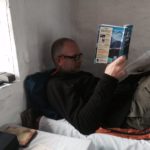 For two nights that’s what we did and were lucky enough to be paired with great roommates who remained friends for the duration of the trip. Prices are set across the board – no haggling allowed, which is fine by us because we’re rubbish at it! The food is fantastic, all freshly cooked, with tons of choice for all meals of the day.
For two nights that’s what we did and were lucky enough to be paired with great roommates who remained friends for the duration of the trip. Prices are set across the board – no haggling allowed, which is fine by us because we’re rubbish at it! The food is fantastic, all freshly cooked, with tons of choice for all meals of the day. 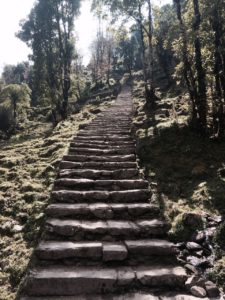
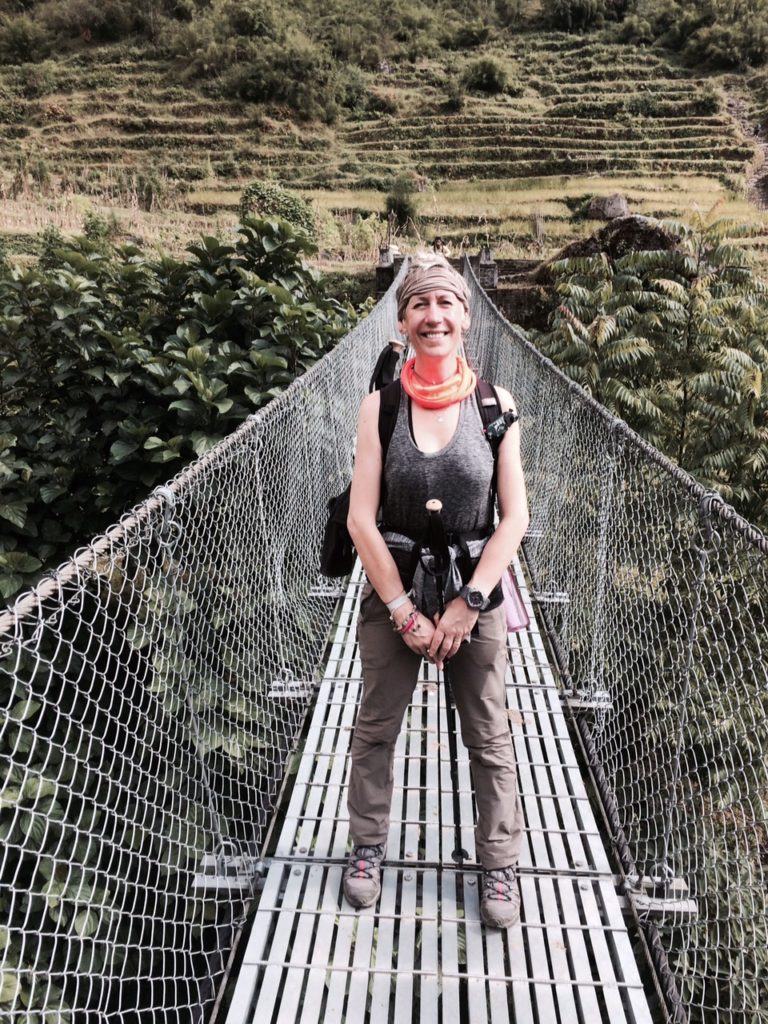
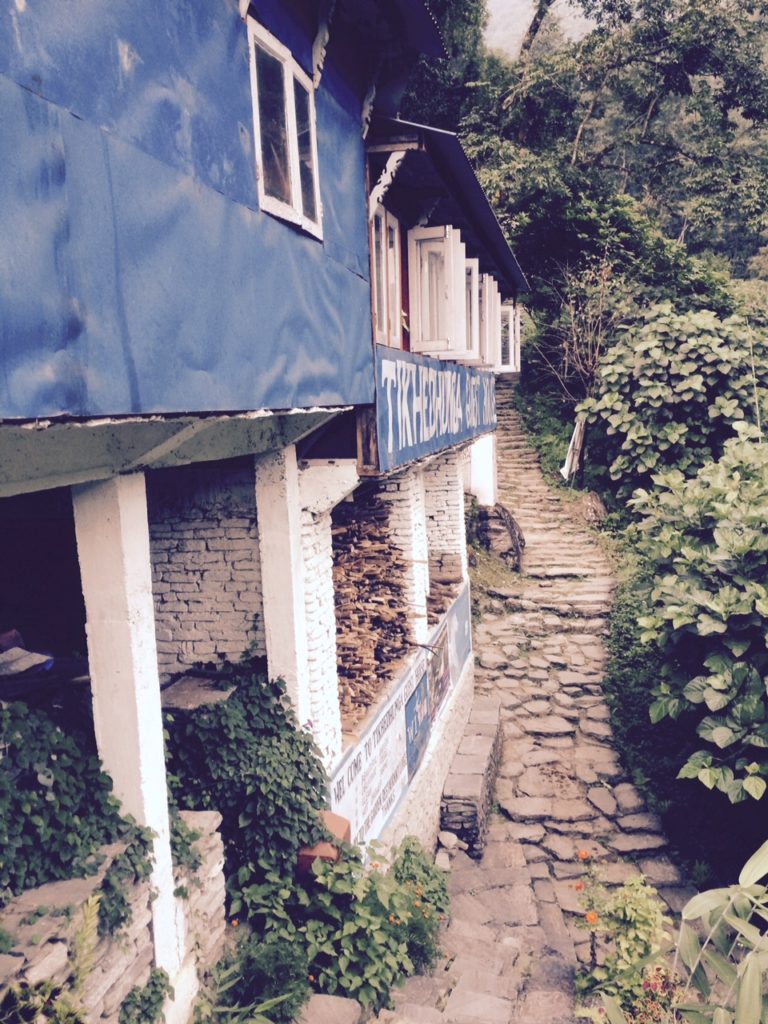
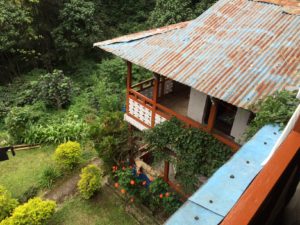

 through a dark alleyway where a small hotel sign was the only hint we were
through a dark alleyway where a small hotel sign was the only hint we were We were completely absorbed by everything around us, the vibrancy of the town and it’s people, but also the fragility of every day life and how easily it can be turned upside down in an instant. When walking through the narrow streets, flanked on either side by high, rickety buildings we couldn’t help but feel just how terrifying it must have been for the people living, working and visiting on 25th April 2015.
We were completely absorbed by everything around us, the vibrancy of the town and it’s people, but also the fragility of every day life and how easily it can be turned upside down in an instant. When walking through the narrow streets, flanked on either side by high, rickety buildings we couldn’t help but feel just how terrifying it must have been for the people living, working and visiting on 25th April 2015.
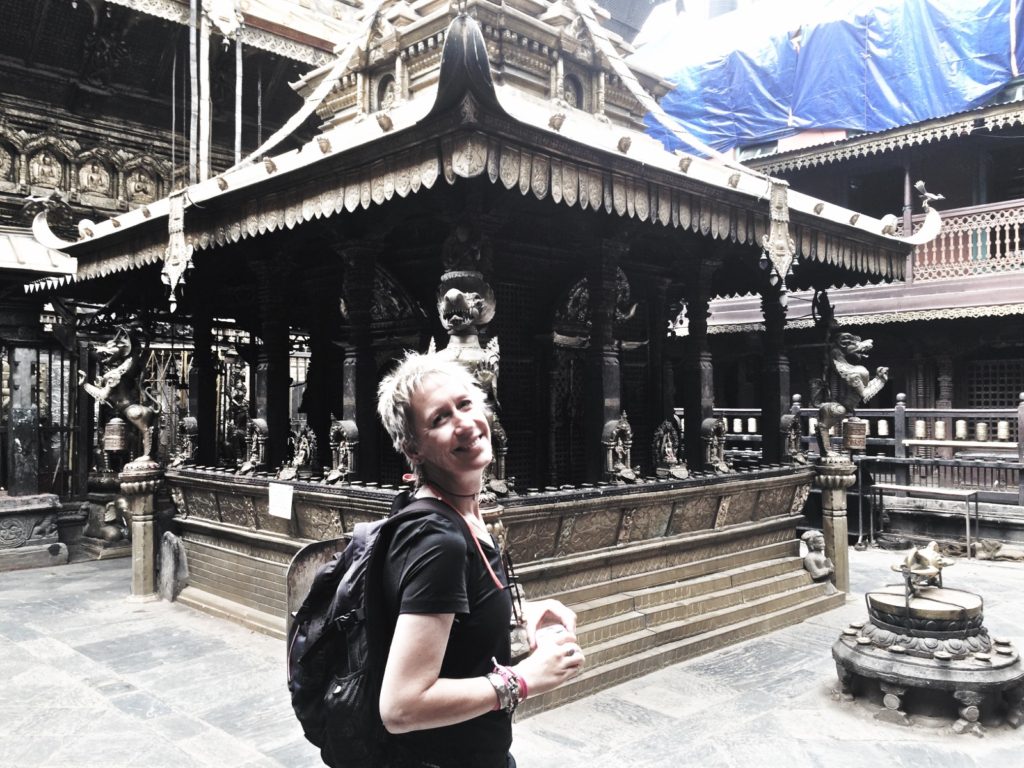
 wandering the streets of the old and VERY touristy district of Thamel. This area is a wonderful insult on the senses – sight, smell, sound, even taste. Wherever you look there’s vibrant colour and bustling life – this is a place of beautiful chaos, it’s totally absorbing and completely mesmerising. We’ve fallen a little bit in love with it!
wandering the streets of the old and VERY touristy district of Thamel. This area is a wonderful insult on the senses – sight, smell, sound, even taste. Wherever you look there’s vibrant colour and bustling life – this is a place of beautiful chaos, it’s totally absorbing and completely mesmerising. We’ve fallen a little bit in love with it!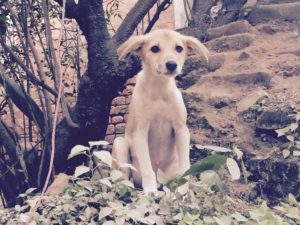
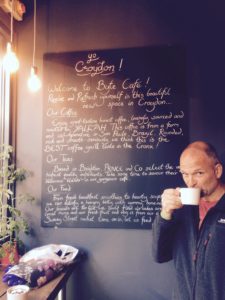 and our carefully calculated daily budget for the next few months compromised in less than 10 minutes!
and our carefully calculated daily budget for the next few months compromised in less than 10 minutes!


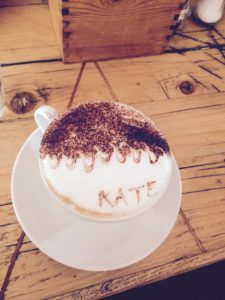
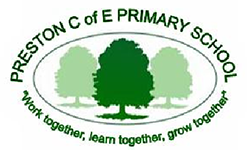 The first school we visited was Preston Primary School. The school is a beautifully modern building – including Steve informed me state of the art plumbing! The staff were so welcoming and the pupils a joy. Nervously we delivered our carefully planned assembly which seemed enthusiastically received. The pupils listened to everything said and asked impressively relevant and well thought through questions with not one mention of bikinis!
The first school we visited was Preston Primary School. The school is a beautifully modern building – including Steve informed me state of the art plumbing! The staff were so welcoming and the pupils a joy. Nervously we delivered our carefully planned assembly which seemed enthusiastically received. The pupils listened to everything said and asked impressively relevant and well thought through questions with not one mention of bikinis! Next to Huish Primary School and the same warm welcome by the staff followed by the eneviatable “Oh so you’re Mr Opie’s Mum and Dad!”It’s easy to see why Jack
Next to Huish Primary School and the same warm welcome by the staff followed by the eneviatable “Oh so you’re Mr Opie’s Mum and Dad!”It’s easy to see why Jack